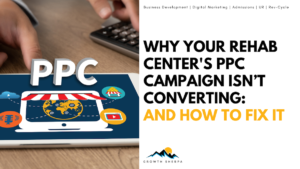There’s no shortage of data in digital marketing—dashboards full of graphs, platforms firing off monthly reports, and more acronyms than anyone asked for. But as a behavioral health executive, you don’t have time to translate vanity metrics into business value. You need clarity on what’s working, what’s wasting money, and what’s driving real admissions. The truth is, many marketing teams are tracking the wrong numbers. And that’s a problem. Because if you’re only looking at clicks and impressions, you’re not seeing the whole picture—or the bottom line.
Here’s a breakdown of the digital marketing KPIs that actually matter for addiction treatment and behavioral healthcare organizations, and how to use them to make better decisions.
Cost per Admission (CPA) Is King
You’re not in the business of traffic—you’re in the business of helping people get well. That means the most critical marketing metric isn’t how many people saw your ad or visited your website—it’s how many entered your program and at what cost. Cost per Admission (CPA) tells you how much you’re spending to bring in one paying client. It’s the North Star of addiction treatment marketing metrics, and everything else should ladder up to it.
That means your Google Ads campaigns shouldn’t just be optimized for conversions—they should be integrated with your call tracking and CRM to report on which leads actually converted into admissions. If you’re not tying ad spend to outcomes, you’re not measuring performance—you’re just guessing.
Lead Quality Over Lead Volume
Let’s say you had 200 form fills last month. Great. But how many of those were insured, appropriate for your level of care, and admitted? If the answer is “not many,” then you’re chasing the wrong goal.
Behavioral health marketing KPIs should reflect quality, not just quantity. Track how many marketing-generated leads were deemed viable by your admissions team. Monitor contact-to-assessment rates. Evaluate pre-qualification data like location, payer source, and presenting concern. Higher quality leads mean less friction in admissions, higher conversion rates, and a more sustainable pipeline. Your PPC or SEO vendor shouldn’t just report how many people clicked—they should report how many were a match for your program and what the conversion rate was by lead source.
Attribution That Actually Works
If you’re spending across Google Ads, paid social, email, referral sites, and organic content, you need to know which channels are pulling their weight. That’s where marketing attribution comes in—but it has to be more than Google Analytics goals.
Real attribution for behavioral health needs to include:
- Dynamic phone call tracking (CallRail, CTM)
- CRM integrations that trace a lead from first click to admission
- Lead source tracking across web forms, chatbots, and call-in numbers
- Cross-channel attribution to account for multi-touch decision journeys
If your attribution model doesn’t reflect the real path to treatment—which can include repeat visits, family involvement, and multiple phone calls—you’ll undervalue key channels or double down on the wrong ones. That’s how campaigns get cut when they were actually driving long-term conversions.
Website Engagement That Signals Intent
Behavioral health websites aren’t e-commerce stores. People don’t land and buy—they read, click, call, and think it over. So metrics like bounce rate and time on site don’t tell the full story unless they’re tied to intent.
Instead of watching pageviews, focus on behaviors that suggest action:
- Visits to insurance verification pages
- Clicks on the “Call Now” button
- Downloads of program brochures
- Repeat visits within a short time frame
These signals can help you understand what content is working, what needs improvement, and what’s driving users to take the next step. That’s the kind of web insight that feeds smarter content and SEO strategies.
Marketing Metrics Need Operational Context
Here’s where most marketing dashboards fall short—they report performance without connecting it to operations. But in behavioral health, the gap between a lead and an admission is filled with real-world complexity.
Maybe your CPA looks high because your admissions team was understaffed for two weeks. Maybe a drop in conversions happened the same month you paused a crucial brand campaign. Maybe your strongest PPC campaign is getting overruled by an IVR system that routes calls poorly.
Without operational context, metrics lie. That’s why Growth Sherpa works alongside leadership, admissions, and marketing to ensure data drives decisions across the board.
Turn Metrics Into Momentum
When you start measuring what really matters—admissions, lead quality, source attribution, and engagement intent—your marketing efforts become more than just a cost center. They become a performance engine.
We help behavioral health organizations move beyond vanity metrics and into true digital ROI. Because at the end of the day, you don’t need more data—you need better outcomes.
If your current reports aren’t giving you the answers you need, let’s talk. We’ll help you connect the dots from clicks to care.




